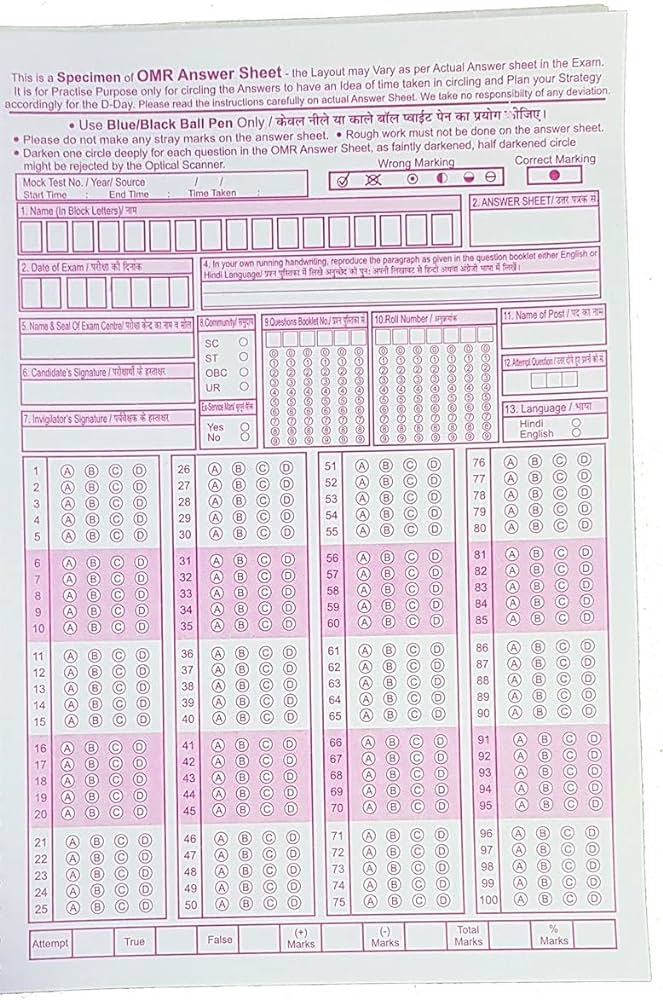In the age of digitalization and technological advancement, the humble Optical Mark Recognition (OMR) sheet might seem like a relic of the past. However, this seemingly simple piece of paper holds immense potential, particularly in fields where quick and accurate data collection is crucial. In this blog post, we delve into the world of OMR sheets, exploring their uses, advantages, and best practices for implementation.
What is an OMR Sheet?
An OMR sheet, also known as a bubble sheet or answer sheet, is a specially designed form used for multiple-choice assessments or surveys. It consists of a series of questions or statements, each accompanied by a set of bubbles or checkboxes. Respondents mark their answers by shading or filling in these bubbles, which can then be scanned and processed electronically.

Applications of OMR Sheets
- Educational Assessments: OMR sheets are extensively used in educational institutions for conducting examinations, quizzes, and surveys. They streamline the process of grading and analyzing responses, saving time and reducing human error.
- Recruitment and Surveys: Many organizations utilize OMR sheets for recruitment tests, entrance exams, and employee surveys. The structured format simplifies data collection and facilitates objective evaluation.
- Election Ballots: In some regions, OMR technology is employed for processing paper ballots during elections. It ensures accuracy and transparency in the voting process, enhancing public trust in the electoral system.
- Data Collection in Research: Researchers often utilize OMR sheets for collecting quantitative data in surveys and experiments. The standardized format enables systematic analysis and comparison of responses.
Advantages of OMR Sheets
- Speed and Efficiency: OMR technology enables rapid data capture and processing, significantly reducing the time required for assessment or survey administration.
- Accuracy: OMR systems are highly accurate in interpreting marked responses, minimizing errors associated with manual data entry or interpretation.
- Cost-Effectiveness: Compared to other data collection methods, such as manual entry or digital surveys, OMR sheets offer a cost-effective solution, especially for large-scale assessments.
- Flexibility: OMR sheets can accommodate various question formats, including multiple-choice, true/false, and Likert scale items, making them adaptable to different assessment needs.
Best Practices for Using OMR Sheets
- Design Clarity: Ensure that the OMR sheet design is clear and user-friendly, with distinct markings for each response option. Avoid clutter and ambiguity to minimize respondent errors.
- Quality Printing: Use high-quality paper and printing techniques to ensure optimal scanning accuracy. Faint or smudged markings can lead to misinterpretation of responses.
- Testing and Calibration: Before conducting assessments, perform thorough testing and calibration of OMR scanning devices to ensure reliable data capture and processing.
- Security Measures: Implement appropriate security measures to prevent tampering or unauthorized access to OMR sheets, especially in high-stakes assessments or elections.
Conclusion
Despite the rise of digital alternatives, OMR sheets remain a valuable tool for efficient data collection and processing in various fields. By understanding their potential and implementing best practices, organizations can harness the benefits of OMR technology to streamline processes, enhance accuracy, and make informed decisions based on reliable data. Whether in education, recruitment, or research, the humble OMR sheet continues to play a significant role in modern data management.
To read the brochure of OMR Scanner. Click Here